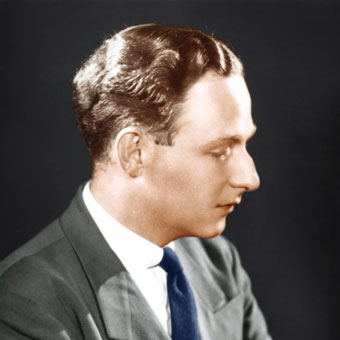
Irving Fine
An introduction to Fine’s music
by Phillip Ramey
Irving Fine (1914-1962) was an American composer with a remarkable gift for lyricism, whose masterfully crafted scores inevitably "sing". Aaron Copland has written that his music "wins us over through its keenly conceived sonorities and its fully realised expressive content", praising it for "elegance, style, finish and a convincing continuity". Virgil Thomson has cited an "unusual melodic grace".
Fine’s initial training was in piano and he became a skilled pianist, admired by colleagues for his superior sight-reading ability. Composition and theory studies were with Walter Piston and Edward Burlingame Hill at Harvard University, and with Nadia Boulanger in France and at Radcliffe College, Cambridge, Massachusetts. In addition, Fine studied choral conducting with Archibald T Davidson at Harvard and orchestral conducting with Serge Koussevitzky at Tanglewood. At Harvard, where he became a close associate of Copland, Stravinsky, Koussevitzky and Leonard Bernstein, he taught theory and music history from 1939 to 1950; and at Brandeis University he taught composition and theory from 1950 to 1962. Fine also conducted the Harvard Glee Club, and for nine summers between 1946 and 1957 taught composition at the Berkshire Music Center at Tanglewood. At Brandeis he was Walter W Haumburg Professor of Music and Chairman of the School of Creative Arts. He suffered a fatal heart attack in Boston on August 23, 1962, leaving incomplete an opera, Maggie: A Girl of the Streets (based on the Stephen Crane novel) and a violin concerto. Among the composer’s honours were two Guggenheim Fellowships, a Fulbright Research Fellowship, a National Institute of Arts and Letters award and a New York Music Critic’ Circle award.
An examination of Fine’s small but estimable output reveals a composer who was a perfectionist on the order of Copland and Stravinsky. His works are carefully calculated and detailed, their ever-increasing emphasis on melody tellingly allied with rhythmic suppleness, clean sounding textures and unobtrusive but integral counterpoint.
As an artist Fine was eclectic, but in the best sense: assimilative yet individual. The influence of neo-Classical Stravinsky and eighteenth century forms is pervasive in much of his early music, along with what proved to be a lifelong attachment to romantic expression. The 1946 Sonata for Violin and Piano was accurately described by the composer as being in an idiom "essentially tonal, diatonic, moderately dissonant, new-Classic in its formal approach". Fine’s new-Classicism, nurtured early on by Nadia Boulanger, is apparent even in the movement-titles of pieces such as the 1947 Music for Piano and the 1948 Partita for Wind Quintet (for instance, "Variations", "Gigue", "Waltz-Gavotte"). However, the ebulliently rhythmic Toccata Concertante for Orchestra of 1947 – which has, wrote the composer, "a certain affinity with the energetic music of the Baroque concertos" – stands as the most full blown example of neo-Classic Fine.
Subsequently, romanticism claimed pride of place, and in the elegantly bittersweet Notturno for Strings and Harp (1951), the harmonically diverse song-cycle Mutability (1952) and the austerely elegiac Serious Song: Lament for String Orchestra (1955) the result was a more intense lyricism. With such works he proved himself capable of writing melody which, as he once noted admiringly of another composer, "gives real pleasure to lots of people without being commonplace". It is not surprising that Notturno and Serious Song are the most frequently played of Fine’s orchestral compositions. (Also programmed often are his highly idiomatic, unfailingly lyric and varied choral works – Alice in Wonderland, The Hour-Glass, The Choral New Yorker.)
The final development in Fine’s aesthetic was his utilisation of twelve tone technique, initially in the eloquent, intense String Quartet of 1952, then in the pellucid Fantasia for String Trio of 1956, culminating in what was to be his last work, the dramatic Symphony (1962). His interest in serialism had been provoked by the example of Stravinsky and Copland, and like his elder colleagues he was able to use dodecaphonic method freely and subordinate it to his personal musical ideals. Fine’s serially inflected scores have tonal centres, and also the formal and textural clarity, the sense of control and the rhythmic potency of his earlier pieces. Copland described Symphony (1962), the composer’s most ambitious work, as being "almost operatic in gesture", and its urgent rhythmic polyphony, declamatory rhetoric and considerable dissonance quotient marked a new plateau in Fine’s creative evolution – one that must forever intrigue as both a beginning and an end.
© Phillip Ramey, 1989
(Composer; Program Editor, New York Philharmonic)
